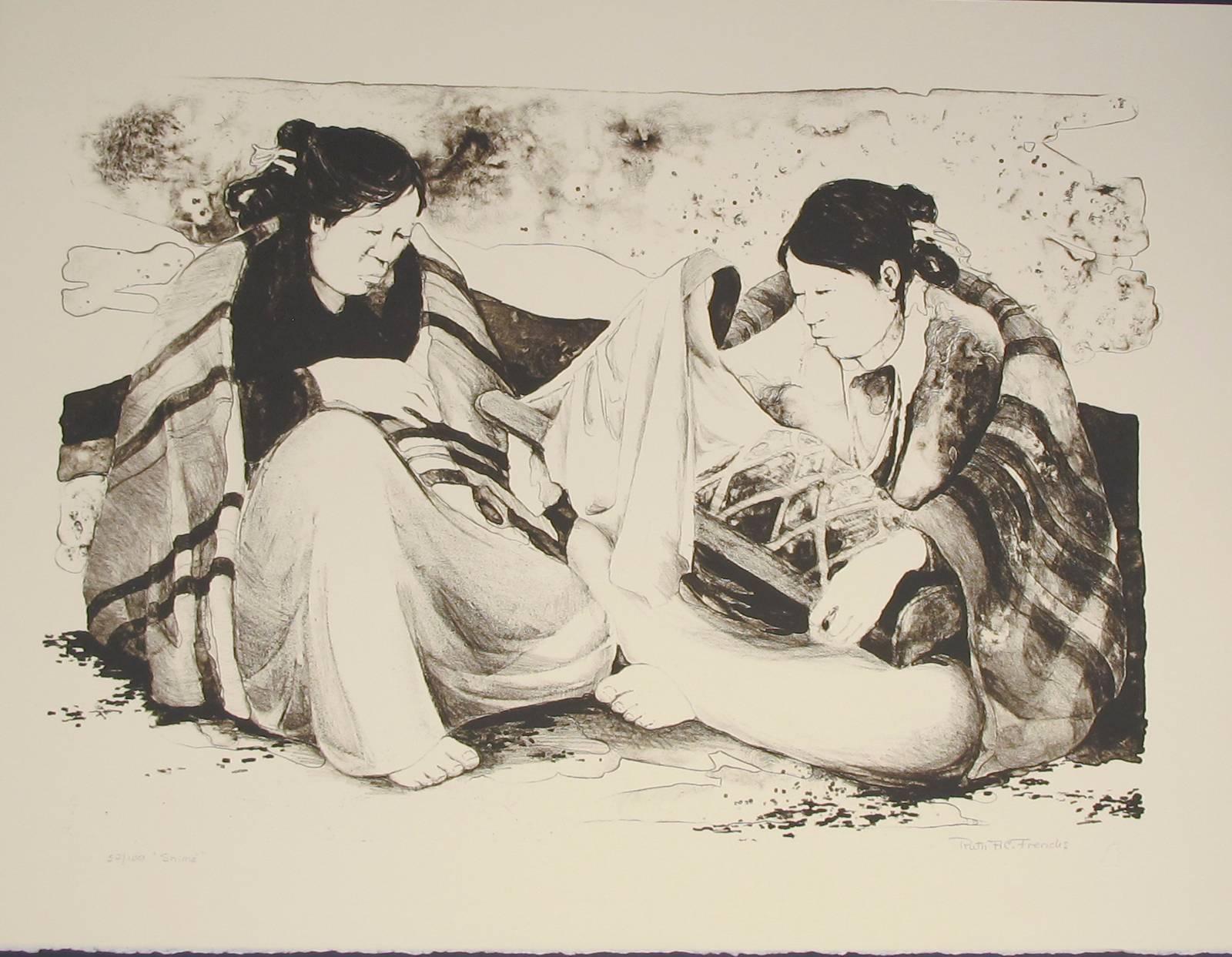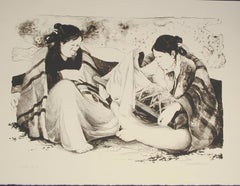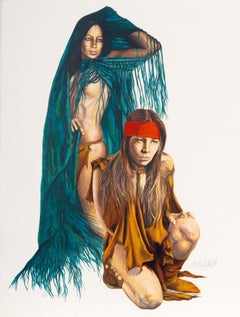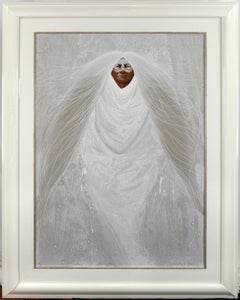Items Similar to Two Native American Girls
Want more images or videos?
Request additional images or videos from the seller
1 of 9
Popo and Ruby LeeTwo Native American Girlsc.1990
c.1990
$900
£674.82
€782.35
CA$1,256
A$1,402.83
CHF 728.96
MX$17,083.70
NOK 9,259.36
SEK 8,724.99
DKK 5,837.29
Shipping
Retrieving quote...The 1stDibs Promise:
Authenticity Guarantee,
Money-Back Guarantee,
24-Hour Cancellation
About the Item
This artwork "two Native American Girls" c. 1990 is a color offset lithograph by noted artists Popo and Ruby Lee, b.1940. It is Hand signed and numbered 501/750 in pencil by the artist. The image size is 29 x 20 inches, sheet size is 32 x 25 inches. It is in excellent condition, has never been framed.
About the artists:
Popo and Ruby Lee are artist-legends on the Central Coast. They met and married during the heyday of counterculture in San Francisco, but worked and lived in Ojai for five years. Both had worked as solo artists before they met, but one day on North Beach, in 1972, a handsome, dark-eyed man said to the pretty, petite Ruby Lee, “Let’s do a painting together!,” and the rest is history. A website dedicated to Ruby Lee, says that neither artist was in the habit of signing canvases, until one day in Ojai when the vice president of Disney Productions negotiated for one of their jointly painted canvases, clinching the deal by asking for a signature. So Ruby signed both “Popo and Ruby Lee,” and, as stated on the site mentioned above, “a Myth was born.” Many artists, Ruby Lee among them, paint in a series informed by their philosophy or worldview at a specific era of their lives. Therefore, a group of works may have a common theme or mood, indicated by similar scale, subjects, palettes and titles. Ruby Lee, in the early to mid-1970s, had a series called “Morning Prayer,” which includes this portrait. Ruby Lee’s life indeed included the study of yoga and tai chi. In fact, when she arrived from London to New York City in 1969, after a bohemian trek across Europe, she headed for Northern California, where she had heard about the flower children and the beliefs of American Indians
- Creator:Popo and Ruby Lee (1948, American)
- Creation Year:c.1990
- Dimensions:Height: 32 in (81.28 cm)Width: 25 in (63.5 cm)Depth: 0.01 in (0.26 mm)
- Medium:
- Movement & Style:
- Period:
- Condition:
- Gallery Location:San Francisco, CA
- Reference Number:Seller: pop/rub/two/nat/011stDibs: LU66638419972
About the Seller
5.0
Platinum Seller
Premium sellers with a 4.7+ rating and 24-hour response times
Established in 1999
1stDibs seller since 2017
805 sales on 1stDibs
Typical response time: 1 hour
- ShippingRetrieving quote...Shipping from: San Francisco, CA
- Return Policy
Authenticity Guarantee
In the unlikely event there’s an issue with an item’s authenticity, contact us within 1 year for a full refund. DetailsMoney-Back Guarantee
If your item is not as described, is damaged in transit, or does not arrive, contact us within 7 days for a full refund. Details24-Hour Cancellation
You have a 24-hour grace period in which to reconsider your purchase, with no questions asked.Vetted Professional Sellers
Our world-class sellers must adhere to strict standards for service and quality, maintaining the integrity of our listings.Price-Match Guarantee
If you find that a seller listed the same item for a lower price elsewhere, we’ll match it.Trusted Global Delivery
Our best-in-class carrier network provides specialized shipping options worldwide, including custom delivery.More From This Seller
View AllThree Native American Girls
By Popo and Ruby Lee
Located in San Francisco, CA
This artwork "Three Native American Girls" c. 1990 is a color offset lithograph by noted artists Popo and Ruby Lee, b.1940. It is Hand signed and numbered 2/750 in pencil by the arti...
Category
Late 20th Century American Realist Nude Prints
Materials
Lithograph
Navajo Women, state #2
By Rudolph Carl Gorman
Located in San Francisco, CA
This artwork "Two Native American Women" 1980 Is an original lithograph on creme Arches paper by renown Navajo artist Rudolph Carl Gorman, 1932-2005. It is signed, dated and numbere...
Category
Late 20th Century Realist Figurative Prints
Materials
Lithograph
Ach-Hua Dlubh: (Body Two) Half Breed
Located in San Francisco, CA
This artwork titled " Ach-Hua Dlubh: (Body Two) Half Breed" 1989 is a color offset lithograph on Artcote paper by Crow Indian artist Penni Anne Cross ...
Category
Late 20th Century Realist Figurative Prints
Materials
Lithograph
Untitled, Two Women
By Mario Cespedes
Located in San Francisco, CA
This artwork "Untitled, Two Women" c.1990 in a mixed media (Acrylic paint on off set lithograph) by Bolivian artist Marion Ferrer (Mario) Cespedes, b1942It is hand signed and numbere...
Category
Late 20th Century Modern Figurative Prints
Materials
Mixed Media
Waiting Women
By Rudolph Carl Gorman
Located in San Francisco, CA
This artwork, titled "Waiting Women", 1976 is an original color lithograph by renown Navajo artist Rudolph Carl Gorman, 1932-2005. It is hand-signed, dated and numbered 63/120 in pencil by the artist, also dedicated "To Purificacion Ramirez" With the blindstamp of the artist and another blindstamp. The sheet size is 22 x 30 inches, framed size is 22.5 x 30.5 inches. Custom framed in a clear acrylic box. It is in excellent condition. The acrylic box is in good condition with a few very faint scratches.
Artist: R.C. Gorman (1932-2005)
Title: Waiting Women
Medium: Lithograph on Paper
Sheet Size: 22" x 30"
Framed size: 22.5" x 30.5"
Year Produced: 1976
Edition Size: 120 plus proofs (25 proofs) This one: 63/120
About the artist:
Born in Canyon de Chelly, Arizona and raised in a hogan on the Navajo Reservation, R.C. Gorman became one of the Southwest's best known late 20th-century artists. His signature works were Navajo women in a variety of poses. Many persons have been fascinated by the fact that he, an Indian artist, became famous in the white man's world with some calling him the "Picasso of Indian artists". Of this kind of attention, he said: "I wish people would quit pushing my being Indian. The only time I was interviewed as If I were a normal person was by the Jewish Press in Tucson. It was the first time I felt international and almost white". (Samuels 222)
His parents were Carl Nelson...
Category
Late 20th Century Realist Figurative Prints
Materials
Lithograph
Price Upon Request
American Indian Navajo
By Ozz Franca
Located in San Francisco, CA
This artwork "American Indian, Navajo" is a offset lithograph on paper by noted Brazilan artist Ozz Franca, 1928-1991. The image size is 21 x 14.75 inches, framed size is 31.25 x 27 inches. Custom framed in a wooden brown/grey frame, with lith purple matting. It is in excellent condition.
About the artist:
Born October 2, 1928, França (pronounced FRON-suh) grew up in Sao Paulo, Brazil, and from an early age showed talent as an artist, as well as exceptional prowess as a competitive swimmer. At 14 he won first prize at the annual Spring Salon Art Competition. At 15, he qualified for the Brazilian Olympic Swimming Team. With two amazing talents, França was unsure what he should do with his life. Fate stepped in, and the Olympic Games were canceled the year França was to compete due to the outbreak of World War II. At that point, he decided to devote his life to art.
He held his first one-man show at the age of 18. Following what he would later say was the best advice anyone ever gave him, França came to the U.S, to accept a scholarship in Utah. A year later, he moved to Hollywood and began doing movie illustration for Walt Disney. His projects included Lady and the Tramp and 20,000 Leagues Under the Sea. He moonlighted as a swimmer when movie parts were available.
França painted many subjects, but he is best known for his esoteric images of Native American women. França's art enters the world of fantasy and dreams, where the spiritual meets the sensual. His works, with their floating imagery and airy, muted colors, evoke an aura of mystery. França said he always painted his subjects, which primarily were women, either in profile, looking toward the edge of the painting, or looking over her shoulder, "so that anyone could walk into it."
Joan Lee, print marketing professional, said that Ozz saw the spirituality and quiet dignity of Native American men and women. "there's a romance surrounding Native Americans that people appreciate seeing," said Lee.
Ozz França died in 1991.
Ozz Franca’s work is held in the collections of numerous celebrity, including:
Jacqueline Onassis
Lyndon B. Johnson
Patty Duke
Jerry Lewis
Kim Novak
Burt Lancaster
Gig Young
Tom Bradley
Sammy Davis, Jr.
Ronald Reagan
Red Skelton...
Category
Late 20th Century Realist Figurative Prints
Materials
Lithograph
You May Also Like
Shime, by Ruth Frerichs, Navajo, women, child, lithograph, limited edition
By Ruth Frerichs
Located in Santa Fe, NM
Shime, by Ruth Frerichs, Navajo, women, child, lithograph, limited edition
Black and white lithograph by Ruth Frerichs
Ruth Concord Frerichs was born in White Plains, New York, ear...
Category
1970s Contemporary Figurative Prints
Materials
Lithograph
Shawl, Lithograph by Popo and Ruby Lee
By Popo and Ruby Lee
Located in Long Island City, NY
Artist: Popo and Ruby Lee
Title: Shawl
Year: circa 1980
Medium: Lithograph, signed and numbered in pencil
Edition: 284/400
Size: 32 x 24 in. (81.28 x 60.96 cm)
Category
1980s Contemporary Figurative Prints
Materials
Lithograph
"Conception" - Portrait of a Native American on a Vision Quest
Located in Soquel, CA
"Conception" - Portrait of a Native American on a Vision Quest
Large scale and fine detailed work by the artist. Detailed and evocative depiction of a Native American elder by Frank Howell...
Category
1990s Surrealist Figurative Prints
Materials
Laid Paper, Screen
$3,080 Sale Price
20% Off
Pair of Vintage Native American Portraits
Located in Soquel, CA
Pair of two vintage portraits of Native American figures, one older and one younger, in profile with braids and headdresses by Victor S. ...
Category
1960s American Impressionist Figurative Paintings
Materials
Canvas, Oil, Cardboard
'Two Women', Yale, Cooper Union, Prix de Rome, Tyler School of Art, Smithsonian
By Alan Feltus
Located in Santa Cruz, CA
Signed lower right, 'Alan Evan Feltus' (American-Italian, born 1943), dated 1981 and with number and limitation, '58/60'. Blind stamped, lower right, 'E.P.' for Editions Press and stamped, verso, 'Editions Press'.
Paper dimensions: 20.5 x 26 inches.
This contemporary classical painter of the human figure first studied at the Tyler School of Art at Temple University in Philadelphia and, subsequently, at Cooper Union in New York City, where he received his BFA in 1966. In 1968, he earned his MFA from Yale University. Over the course of a distinguished career, Alan Feltus has been the recipient of numerous prizes, medals and juried awards including the Prix de Rome...
Category
1980s Modern Figurative Prints
Materials
Laid Paper, Etching
Native American Girl with Doll
By Dave Powell
Located in Missouri, MO
Native American Girl with Doll
By Dave Powell (American, b. 1954)
Signed on Back
17.5" x 8"
Dave Powell is a native son of Montana, in a world of change and transition; few can say they have roots in a single geography that go back four generations. Dave's pedigree in art is just about as deep. He is the son of artists Ace Powell and Nancy McLaughlin Powell. That heritage leads back to the likes of Charlie Russell and Joe De Young, both famous for their abilities to "tell the story" through their art. His father, Ace Powell, was a prolific Western artist whose first childhood paint-box set was a gift from Charlie and Nancy Russell.
Dave became a serious student of art in his mid-teens, and has been a professional artist most of his adult life. Over the years he has worked with Bob Scriver, Ned Jacob and Robert Lougheed. Dave will be the first to give thanks...
Category
20th Century American Realist Figurative Sculptures
Materials
Bronze
Price Upon Request





